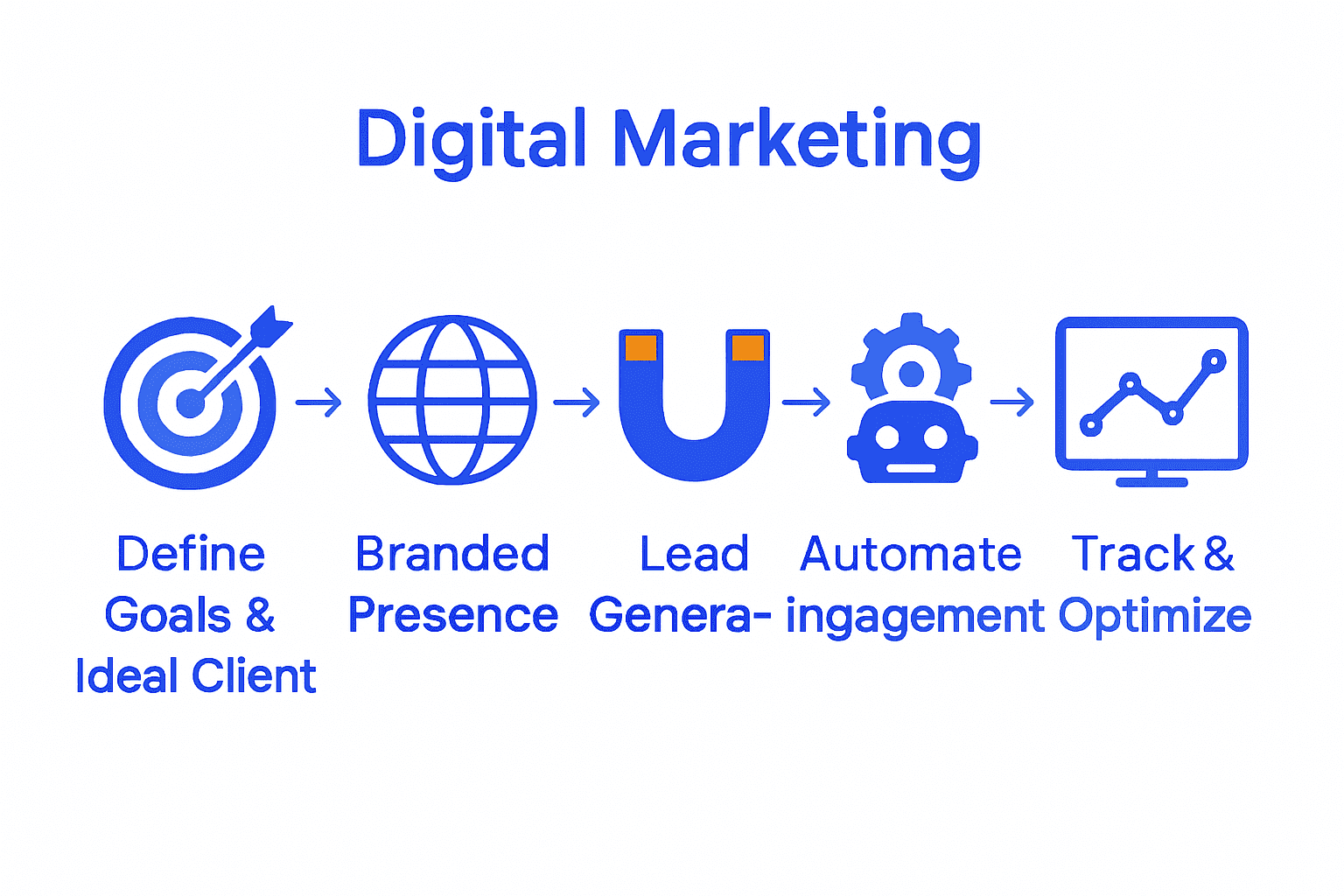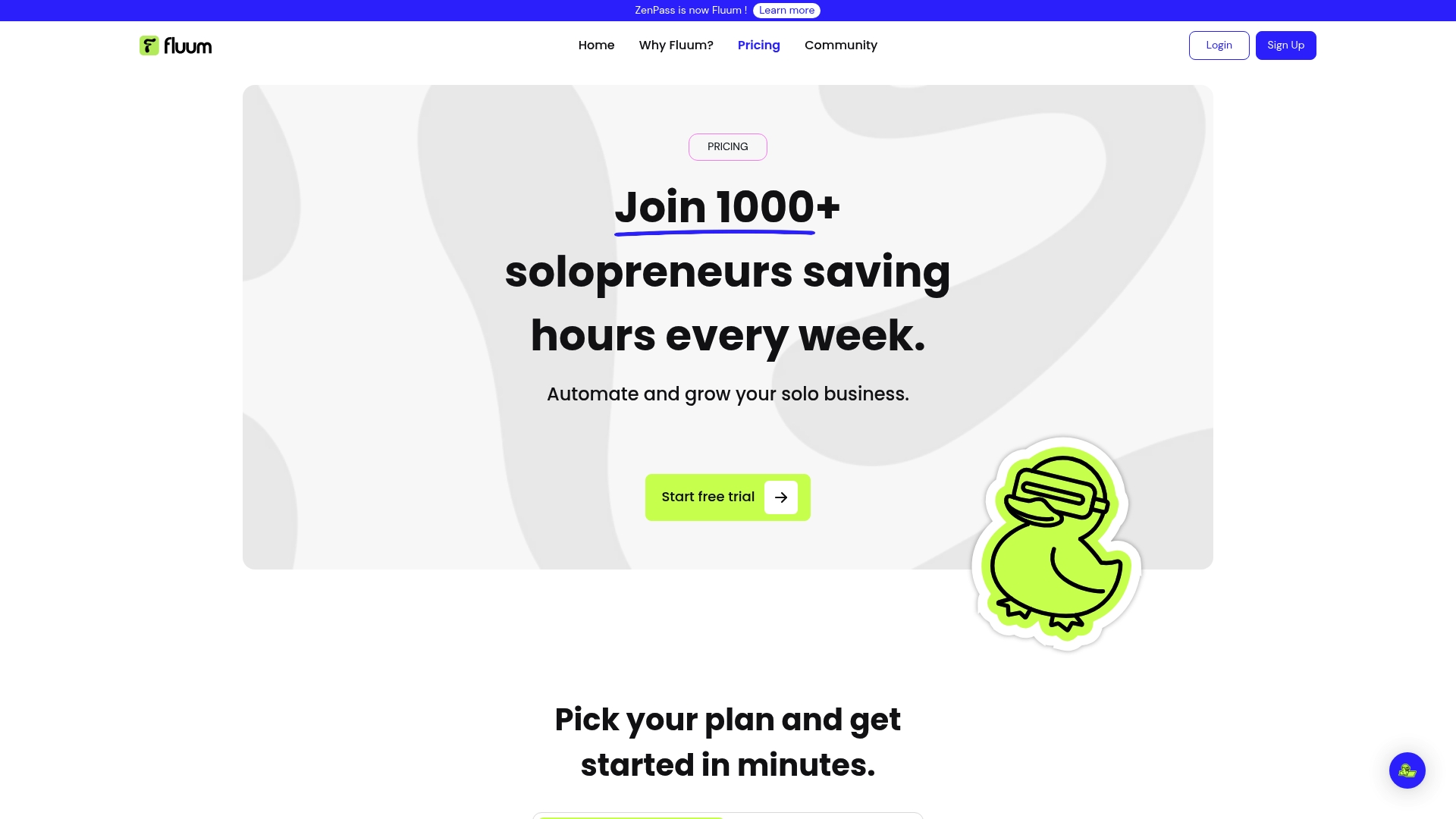
Having digital marketing fundamentals is so important. Did you know that more than 70 percent of solopreneurs struggle to attract consistent clients online? Building a thriving one-person business takes more than just talent. It requires a methodical plan to stand out and earn trust in a crowded digital world. With the right strategy, even solo professionals can develop a magnetic brand, reach their ideal clients, and grow with confidence powered by clear steps and proven tactics.
Quick Summary
| Key Point | Explanation |
|---|---|
| 1. Define Your Ideal Client | Understand who you help and their specific problems to tailor your marketing strategies effectively. |
| 2. Create a Consistent Online Identity | Establish a cohesive digital presence with a custom domain and unified visuals across all platforms. |
| 3. Implement Targeted Lead Generation | Use personalized outreach and content repurposing to attract high-quality leads consistently. |
| 4. Automate Client Engagement Processes | Utilize no-code CRM tools to create efficient automated workflows for client communication and follow-ups. |
| 5. Measure and Optimize Marketing Efforts | Regularly analyze performance metrics to refine strategies and improve overall marketing effectiveness. |
Table of Contents
- Step 1: Define Goals And Ideal Client Profile
- Step 2: Set Up Branded Online Presence
- Step 3: Implement Lead Generation Strategies
- Step 4: Automate Client Engagement And Follow-Up
- Step 5: Track Performance And Optimize Campaigns
Step 1: Define goals and ideal client profile
This step is about getting crystal clear on who you help and what specific outcomes you deliver. When you understand your ideal client deeply, your marketing becomes laser focused and compelling.
Start by asking yourself three fundamental questions: Who do I help the most? What specific problems can I solve? Where do my potential clients spend time online? According to research from GoDaddy, identifying your target audience requires understanding their core desires and frustrations.
Create a detailed client avatar by mapping out their characteristics. Imagine them vividly: What keeps them up at night? What are their professional challenges? What solutions are they desperately seeking? As Arvind Devalia suggests, this clarity helps break cycles of inconsistent marketing and builds structured lead generation.
Research where your ideal clients congregate online. Are they scrolling through Reddit threads? Asking questions on Quora? Networking in specific Facebook groups? These digital spaces are goldmines for understanding their language, pain points, and aspirations.
Pro Tip: Don’t just guess. Spend time actively listening in these online communities before crafting your messaging.
Once you have your client profile, align your goals directly with their needs. Your business objectives should precisely match the transformations you can create for your specific audience. This alignment turns generic marketing into powerful, resonant communication.
In the next step, you will transform this client understanding into a compelling brand narrative that attracts exactly the right people.
Step 2: Set up branded online presence
In this step, you will create a cohesive online identity that makes you memorable and professional across digital platforms. Your goal is to craft a visual and messaging strategy that instantly communicates who you are and what you offer.
Start with securing a custom domain name that reflects your personal or business brand. According to research from Jnoz, even a low-cost setup can generate significant visibility and opportunities. Look for services like Carrd that allow you to create simple yet effective landing pages without requiring advanced technical skills.
Establish a consistent visual identity that speaks your professional language. As insights from Trynggi recommend, this means choosing a specific color palette, selecting professional fonts, and creating a recognizable logo that you can use across all your digital touchpoints. Your visual brand should look the same whether someone finds you on LinkedIn, your website, or messaging platforms.
Pay special attention to your profile photos and bio. Choose a high-quality, professional headshot that represents your personal style while looking approachable. Craft a clear one-liner bio that succinctly explains what you do and who you help. This consistency builds recognition and trust with potential clients.

Pro Tip: Use the same profile picture across all platforms to help people recognize you instantly.
Learn more about building a strong personal brand to differentiate yourself in a crowded digital marketplace.
In the next step, you will develop a content strategy that amplifies your newly established brand identity.
Step 3: Implement lead generation strategies
This step will transform how you attract potential clients by creating strategic approaches that bring quality leads directly to your business. Your goal is to build a reliable system that consistently connects you with ideal customers.
According to research from Saleshandy, solopreneurs can efficiently generate leads through targeted strategies like crafting personalized cold email sequences and repurposing content across multiple platforms. Think creatively about turning one piece of content into various assets that showcase your expertise.
Email campaigns remain a powerful tool. As insights from Fuzen suggest, focus on creating personalized messages with clear calls to action. Develop email sequences that speak directly to your ideal client’s pain points and demonstrate the unique value you provide.
Engage strategically in online communities where your target audience congregates. Look for niche Slack groups, professional forums, and specialized social media communities. Share valuable insights, answer questions, and position yourself as an approachable expert without being overly salesy.
Pro Tip: Always prioritize relationship building over immediate sales. Genuine connections often lead to more sustainable business opportunities.
Learn more about effective lead generation strategies for freelancers to refine your approach and attract high-quality clients.
In the next step, you will explore how to convert these generated leads into actual paying clients.
Step 4: Automate client engagement and follow-up
This step will help you create a seamless client communication system that saves time and ensures no potential opportunity slips through the cracks. Your goal is to build an intelligent follow-up process that feels personal yet operates with minimal manual intervention.
According to research from Fuzen, solopreneurs can leverage no-code CRM solutions to customize workflows that integrate multiple communication channels. Look for tools that connect your email, calendar, scheduling platforms, and payment systems into one streamlined ecosystem.
Start by mapping out your typical client journey. Create automated email sequences that trigger based on specific client actions. These might include welcome messages, follow-up prompts after initial consultations, or reminder sequences for potential clients who have shown interest but not yet committed.
As insights from Sublime360Media suggest, focus on measuring key engagement metrics. Track click-through rates, response times, and inquiry conversions to continuously refine your automation strategy. This data-driven approach helps you protect your energy while maintaining a high-touch client experience.
Pro Tip: Always include a personal touch in your automated workflows. Automated does not mean impersonal.
Learn more about automating client onboarding processes to create smooth, professional client interactions.
In the next step, you will learn how to track and optimize your marketing efforts for sustained growth.
Step 5: Track performance and optimize campaigns
This step will transform your marketing from guesswork into a strategic, data-driven approach that continuously improves your business results. Your goal is to understand what truly works and consistently refine your marketing efforts.
According to research from Jnoz, leveraging analytics tools is crucial for monitoring your content’s performance. Start by setting up Google Analytics and platform-specific insights on your social media channels. Look for patterns in what content generates the most engagement, which formats attract your ideal clients, and where your audience spends the most time.
As insights from Sublime360Media suggest, focus on tracking meaningful metrics that directly impact your business. These include subscriber growth, engagement rates, click-through percentages, inquiry volume, and sales conversions. Each metric tells a story about how effectively you are connecting with potential clients.

Develop a monthly review process where you analyze these metrics. Which content pieces drove the most inquiries? What messaging resonated most with your target audience? Use these insights to refine your marketing strategy, adjusting your content, offers, and communication channels to improve conversion rates.
Pro Tip: Treat your marketing analytics like a compass not a crystal ball. Trends change, so stay flexible and keep learning.
Learn more about optimizing ad campaign performance to maximize your marketing investments.
In the final step, you will learn how to sustain and scale your solopreneur marketing efforts.
Here’s a summary of key steps and their goals:
| Step | Focus Area | Main Goal |
|---|---|---|
| 1. Define Goals & Ideal Client | Audience understanding | Create precise target profile |
| 2. Branded Online Presence | Consistent identity | Build professional digital brand |
| 3. Lead Generation | Attracting prospects | Generate quality leads consistently |
| 4. Automate Engagement | Client communication | Streamline and personalize follow-up |
| 5. Track & Optimize | Performance analysis | Improve marketing using data |
Ready to Streamline Your Solopreneur Marketing?
Struggling to stay on top of lead generation, client engagement, and brand building all by yourself? The article “Digital Marketing Fundamentals for Solopreneur Success” outlined how exhausting it can be to juggle everything from tracking ideal clients and automating follow-ups to measuring marketing results. Many solopreneurs feel overwhelmed when every task relies on a patchwork of complicated tools. With the right AI-powered system, you can reclaim your time, relieve stress, and focus on the work you love.

Now is the perfect moment to transform your solo business into a well-oiled machine. Explore how Fluum’s all-in-one platform lets you consolidate sales funnels, client management, and automated marketing inside one simple dashboard. Unlock ready-to-use templates, step-by-step growth guides, and seamless integrations that help you confidently apply every strategy from the article. Take your solopreneur journey to the next level today by visiting Fluum and see how easily you can build a magnetic online presence and grow your revenue.
Frequently Asked Questions
How do I define my ideal client profile for digital marketing success?
Identify your ideal client by analyzing their specific problems, desires, and online habits. Start by creating a detailed client avatar that outlines their characteristics and pain points, focusing on who you help the most.
What steps should I take to create a cohesive branded online presence?
To establish a cohesive online identity, secure a custom domain name and craft a consistent visual brand across all platforms. Choose a recognizable logo, select uniform colors and fonts, and ensure your profile photos and bios are aligned.
How can I effectively generate leads as a solopreneur?
Utilize targeted strategies like personalized email campaigns and engagement in online communities where your ideal clients interact. Create a lead generation system that includes nurturing relationships organically to attract quality prospects.
What are the best practices for automating client engagement and follow-up?
Implement no-code CRM solutions to streamline your communication processes and create automated email sequences based on client actions. Map out the client journey and ensure your automated messages retain a personal touch to maintain engagement.
How can I track and optimize my digital marketing performance?
Monitor key metrics such as engagement rates and conversions using analytics tools. Set up a monthly review process to analyze which content performs best and adjust your marketing strategies accordingly to enhance effectiveness.
What should I do to sustain my marketing efforts over time?
To sustain and scale your marketing, continuously refine your strategies based on performance data and emerging trends. Regularly evaluate your goals and client feedback, making adjustments to your messaging and approaches as needed.
Recommended
- Fluum | Effective Stress Management Techniques for Busy Professionals
- Fluum | How to Onboard Clients Effectively for Lasting Success
- Fluum | Master Managing Multiple Projects for Success
- Fluum | Build Your Brand with a Branding Builder in 2025
- Fluum | 7 Customer Retention Examples to Boost Your Business
What Is A Solopreneur? Understanding The Solo Business Model- Understanding Digital Marketing Basics For Success
- Understanding Solopreneur Vs Freelancer: Key Differences
- What is Digital Marketing? Understanding Its Importance
- Master Client Acquisition Through Targeted Ads Strategies – Ads Daddy. Advertise on All Plattforms.



